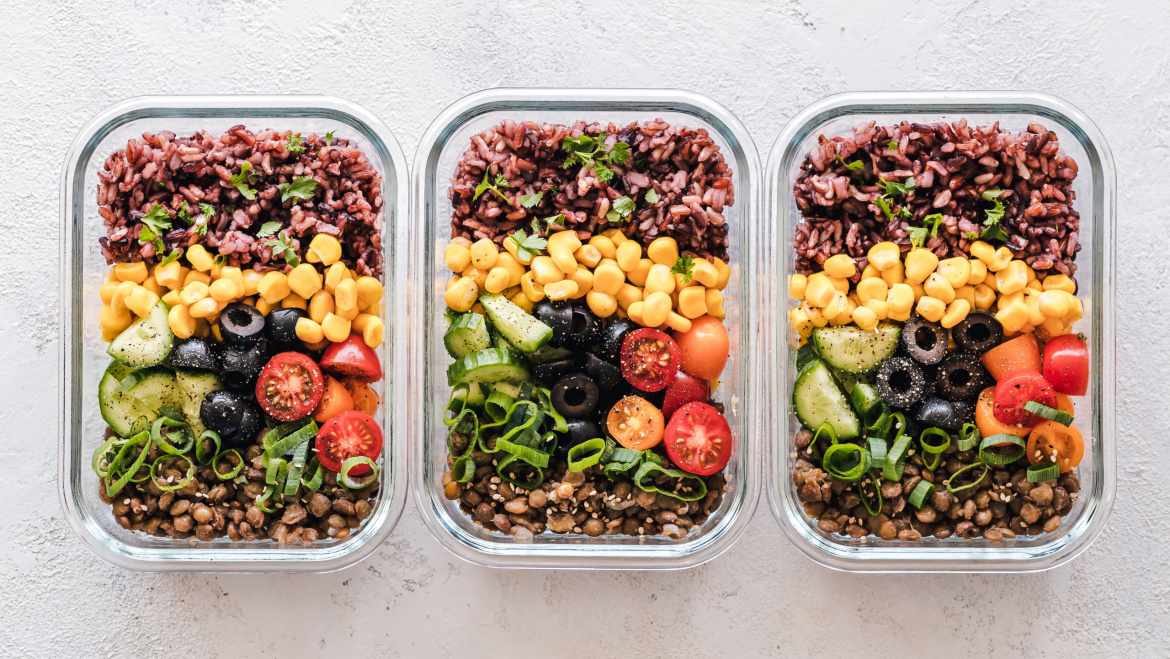How to Get Started
We all know the benefits of meal prepping. It saves us a lot of time and can make eating healthy much more doable. Meal prepping helps you stick to a routine and adds consistency to your life. It can also save you money as groceries are bought with a plan in mind which leaves less waste.
If the thought of meal prepping makes you feel overwhelmed, you are not alone! I see my client’s eyes glaze over when I mention it in session — and they even know that it’s in their best interest. So how can we make it more manageable? Below are some tips for you.
Start Small
You don’t have to do it all at once! Begin by prepping veggies ahead of time. This involves cleaning and chopping veggies and then putting them in glass containers in the fridge. This way you have veggies ready to add to any meal. This is great for onions, peppers, cauliflower, broccoli, sweet potatoes, Brussel sprouts, zucchini, and squash. One of the most time-consuming things with making dinner or lunch is preparing vegetables. Now you’ll have them ready to go for the week.
Prep Snacks
Portion out berries, nut butter, carrots, trail mix, hummus, jerky, etc., in reusable containers. This way, you and your family can grab and go throughout the week. You won’t need to rely on pre-packaged bars with added junk if you have other options just as easy to grab. You also won’t overindulge if they are portioned out ahead of time.
Make Breakfast Ahead of Time
I hear from clients daily that they have trouble figuring out what to eat for breakfast, especially if they must avoid gluten, dairy, and eggs. Make-ahead breakfasts work well for these people and anyone looking to streamline their morning routine. This works well for overnight oats, chia seed puddings, oatmeal bakes, protein balls/power balls, and waffles (make some on the weekend and then stick in the fridge/freezer).
Prep Smoothies
You read that right! Have everything in a blender cup or a mason jar except the ice and liquid. Now all you have to do is blend. This is great for a post-workout smoothie or a busy day.
Have a “Cook Once, Eat Twice” Mindset.
This works great for the people who don’t want to set aside time to make several meals at once. Anytime you’re cooking, think about how you can use that time to make extra of anything you might want to use in another meal. For example, if you’re grilling always do a few extra portions of meat that you can add to salads or wraps in the future. If the oven is on, add a separate baking sheet of roasted vegetables tossed in olive oil for quick sides later. If you’re making rice or pasta, prepare extra so that it is already cooked for a different meal.
Think Things Through and Multitask
A well-thought-out workflow will save you a lot of time in the kitchen. Start with the recipe that requires the longest cook time to best organize your prep. This is often the soup or oven meal. Once that meal is underway, focus on the rest. Utilize different cooking methods at once. While baking and roasting, have things sautéing or hard-boil eggs on the stove top. Have the slow cooker, rice cooker, or instant pot going as you do other things.
Make Your Home like Chipotle
Instead of having five identical salads or grain bowls packed at the start of each week, treat your fridge like an at-home Chipotle. Have your grains, protein, veggies, and greens prepped and stored in separate containers. Then for lunch or dinner, grab whatever prepped ingredients you desire on that day. That simple twist will prevent you from falling into the trap of having the exact same thing five days in a row and getting sick of it by the third time.
Cook in Batches
You can make large batches of a specific recipe like a soup, stew, or chili, then split them into individual portions to be frozen and eaten over the next few months. These are great for the winter when you’re craving warm, hearty foods. It’s also an extra handy way to have a nutrient-dense meal on the table for those who have limited time in the evenings (I’m looking at you parents of kids in sports!).
Buy in Bulk to Stay Under Budget
Buying in bulk saves you money and makes it possible to prepare multiple meals at once. In addition, bulk ingredients are cheaper per unit than buying individually, even though you’re paying more upfront. For example, a 7-pound family-size pack of chicken breast costs is less per pound than a two-pack. Or buying a large bag of brown rice is less expensive than purchasing a four-serving box of rice.
Get Saucy & Spicy
You can completely transform a meal by adding different sauces and spices. Take an adventure to different countries and places just by what you add to it — Indian, southern BBQ, Caribbean, French countryside, Thai, etc. I recommend that you stock up on spices. I have two cabinet shelves full of spices/herbs that I love. They are a delicious low-calorie way to add lots of flavor, excitement, and health benefits to your meals. The same bowl of rice, chicken, and roasted veggies will taste different each time you have it depending on what sauce and spices you add that day.
Pick the Right Containers
You’ll be more motivated to meal prep once you have the right containers for storage. Your food storage containers can make the difference between a fabulous or mediocre meal. We’ve all seen the pretty meal prep images on social media. Look for airtight containers that are washable and reusable silicone baggies/collapsible containers. Things should be BPA-free and try to avoid plastic (especially if you’re going to microwave in it). I use a lot of Pyrex glassware. You can also use wide-mouth mason jars, especially for freezing if you leave at least 1 inch (2.5 cm) of headspace so that the food can expand as it freezes.
Bon Appétit!






Add Comment